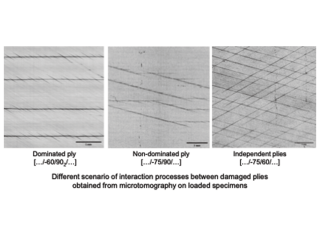From cracking process to permeability of composite laminates in cryogenic environment - Phenomelogical analysis and predictive modeling
The transition to new energy sources involves the development of new storage devices, such as high-pressure gas tanks or cryogenic liquid tanks, especially for hydrogen. Furthermore, reducing energy consumption in transportation relies on lightweight and compact structures. Thanks to their high specific resistances, composite materials are good candidates to meet these new challenges.
Due to the volumetric energy density it allows, cryogenic storage of hydrogen appears to be the only viable solution for heavy vehicles, trains, and aircrafts. The liquid state of the fuel does not require high-pressure storage, leading to thin-walled structures (a few millimeters) that are lightweight and less expensive, although the thermal insulation required for this type of storage can significantly impact mass and cost. Eliminating the liner for composite tanks reduces both mass and cost. However, developing an all-composite tank makes achieving the required tightness a challenging task. Numerous studies have highlighted the connection between composite damage and permeability, with the most critical mechanism being transverse cracking that generates through-thickness crack networks [1,2]. These cracks initiate and coalesce significantly before the structure fails, especially at cryogenic temperatures where polymer matrix become brittle and thermal stresses approach transverse strength.
The initial research on this subject within the I2M focused on the storage of methane or oxygen for space launchers in collaboration with CNES and ArianeGroup. More recently, a collaboration with AIRBUS has started within the framework of the ZEROe concept, in which hydrogen plays a significant role.
The activities aim to propose a leakage flow prediction tool based on a detailed understanding of the damage accumulation scenario in different plies of a laminate subjected to thermomechanical loading. The analysis and characterization approach rely on in-situ observations using microscopy and microtomography of damaged areas under load [3,4]. Original experimental setups allow the creation of a cryogenic environment by spraying or immersing liquid nitrogen around straight specimens subjected to tension or tubes under biaxial loading [5–7]. Virtual tests based on cohesive zone model and finite fracture mechanics complement experimental analyses [8]. These two complementary approaches have led to the construction of a mesoscale model through a multi-scale strategy, maintaining the dual energy-strength criterion to simulate the development of the crack network [3,6]. The model thus includes the effect of ply thickness, interactions between damage in adjacent plies, and the variability of mechanical properties. It has been evaluated on laminates with up to 6 different orientations and subjected to biaxial loading. To date, it can predict connection rates between plies and quantify the emergence of leakage paths. Ongoing work aims to integrate the prediction of leakage flow, taking into account the opening of the crack network under thermomechanical loading.
Références
[1] H. Kumazawa, H. Hayashi, I. Susuki, T. Utsunomiya, Damage and permeability evolution in CFRP cross-ply laminates, Fifteenth Int. Conf. Compos. Mater. ICCM-15 Fifteenth Int. Conf. Compos. Mater. 76 (2006) 73–81. https://doi.org/10.1016/j.compstruct.2006.06.011.
[2] D.M. Grogan, C.M. Ó Brádaigh, J.P. McGarry, S.B. Leen, Damage and permeability in tape-laid thermoplastic composite cryogenic tanks, Compos. Part Appl. Sci. Manuf. 78 (2015) 390–402. https://doi.org/10.1016/j.compositesa.2015.08.037.
[3] H. Laeuffer, Caractérisation et modélisation des réseaux de fissures pour la prédiction de la perméabilité des réservoirs composites stratifiés sans liner, Thèse de doctorat, Arts et Metiers ParisTech, 2017. https://hal.archives-ouvertes.fr/tel-01812568.
[4] C. Bois, J.-C. Malenfant, J.-C. Wahl, M. Danis, A multiscale damage and crack opening model for the prediction of flow path in laminated composite, Compos. Sci. Technol. 97 (2014) 81–89. https://doi.org/10.1016/j.compscitech.2014.04.002.
[5] Y. Accettura, J. Verrecke, T. Briand, C. Bois, J.-C. Wahl, Experimental methods dedicated to the study of cracking process in laminated composites subjected to thermomechanical loadings, in: 16th Cryog., Dresden, 2023.
[6] T. Briand, Caractérisation et modélisation de la relation entre l’endommagement et la perméabilité d’un composite stratifié en condition cryogénique, Thèse de doctorat, Université Bordeaux, 2021. https://tel.archives-ouvertes.fr/tel-03322713.
[7] H. Laeuffer, J. Arbaoui, C. Bois, F. Lavelle, N. Perry, J.-C. Wahl, A new device to measure permeability evolution under pressure loading: Application to CFRP pipes, Measurement. 98 (2017) 68–76. https://doi.org/10.1016/j.measurement.2016.11.023.
[8] J. Verrecke, C. Bois, J.-C. Wahl, Study of intra- and inter-laminar damage interactions in laminated composites using finite fracture mechanics, in: 15th Int. Conf. Fract., Atlanta, USA, 2023.

